| Listing 1 - 10 of 11 | << page >> |
Sort by
|
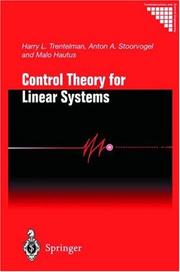
ISSN: 01785354 ISBN: 1852333162 9781852333164 1447110730 1447103394 Year: 2001 Publisher: London : Springer,
Abstract | Keywords | Export | Availability | Bookmark
 Loading...
Loading...Choose an application
- Reference Manager
- EndNote
- RefWorks (Direct export to RefWorks)
Control Theory for Linear Systems deals with the mathematical theory of feedback control of linear systems. It treats a wide range of control synthesis problems for linear state space systems with inputs and outputs. The book provides a treatment of these problems using state space methods, often with a geometric flavour. Its subject matter ranges from controllability and observability, stabilization, disturbance decoupling, and tracking and regulation, to linear quadratic regulation, H2 and H-infinity control, and robust stabilization. Each chapter of the book contains a series of exercises, intended to increase the reader's understanding of the material. Often, these exercises generalize and extend the material treated in the regular text.
Control theory --- Control theory. --- Linear systems. --- Control engineering. --- Robotics. --- Mechatronics. --- Mechanical engineering. --- System theory. --- Control, Robotics, Mechatronics. --- Mechanical Engineering. --- Systems Theory, Control. --- Systems, Theory of --- Systems science --- Science --- Engineering, Mechanical --- Engineering --- Machinery --- Steam engineering --- Mechanical engineering --- Microelectronics --- Microelectromechanical systems --- Automation --- Machine theory --- Control engineering --- Control equipment --- Engineering instruments --- Programmable controllers --- Philosophy

ISBN: 1852332190 1447110676 1447102495 9781852332198 Year: 2001 Publisher: London Springer
Abstract | Keywords | Export | Availability | Bookmark
 Loading...
Loading...Choose an application
- Reference Manager
- EndNote
- RefWorks (Direct export to RefWorks)
At the core of many engineering problems is the solution of sets of equa tions and inequalities, and the optimization of cost functions. Unfortunately, except in special cases, such as when a set of equations is linear in its un knowns or when a convex cost function has to be minimized under convex constraints, the results obtained by conventional numerical methods are only local and cannot be guaranteed. This means, for example, that the actual global minimum of a cost function may not be reached, or that some global minimizers of this cost function may escape detection. By contrast, interval analysis makes it possible to obtain guaranteed approximations of the set of all the actual solutions of the problem being considered. This, together with the lack of books presenting interval techniques in such a way that they could become part of any engineering numerical tool kit, motivated the writing of this book. The adventure started in 1991 with the preparation by Luc Jaulin of his PhD thesis, under Eric Walter's supervision. It continued with their joint supervision of Olivier Didrit's and Michel Kieffer's PhD theses. More than two years ago, when we presented our book project to Springer, we naively thought that redaction would be a simple matter, given what had already been achieved . . .
Interval analysis (Mathematics) --- 519.6 --- Analysis, Interval --- Arithmetic, Interval --- Interval arithmetic --- Interval mathematics --- Mathematics, Interval --- Mathematics --- Numerical analysis --- Computational mathematics. Numerical analysis. Computer programming --- Interval analysis (Mathematics). --- 519.6 Computational mathematics. Numerical analysis. Computer programming --- Software engineering. --- Computational intelligence. --- Computer science—Mathematics. --- System theory. --- Software Engineering/Programming and Operating Systems. --- Computational Intelligence. --- Math Applications in Computer Science. --- Systems Theory, Control. --- Systems, Theory of --- Systems science --- Science --- Intelligence, Computational --- Artificial intelligence --- Soft computing --- Computer software engineering --- Engineering --- Philosophy

ISBN: 3540409521 3540412212 9783540412212 Year: 2001 Volume: 1629 Publisher: Berlin New York Hong Kong Springer
Abstract | Keywords | Export | Availability | Bookmark
 Loading...
Loading...Choose an application
- Reference Manager
- EndNote
- RefWorks (Direct export to RefWorks)
Riemannian, symplectic and complex geometry are often studied by means ofsolutions to systems ofnonlinear differential equations, such as the equa tions of geodesics, minimal surfaces, pseudoholomorphic curves and Yang Mills connections. For studying such equations, a new unified technology has been developed, involving analysis on infinite-dimensional manifolds. A striking applications of the new technology is Donaldson's theory of "anti-self-dual" connections on SU(2)-bundles over four-manifolds, which applies the Yang-Mills equations from mathematical physics to shed light on the relationship between the classification of topological and smooth four-manifolds. This reverses the expected direction of application from topology to differential equations to mathematical physics. Even though the Yang-Mills equations are only mildly nonlinear, a prodigious amount of nonlinear analysis is necessary to fully understand the properties of the space of solutions. . At our present state of knowledge, understanding smooth structures on topological four-manifolds seems to require nonlinear as opposed to linear PDE's. It is therefore quite surprising that there is a set of PDE's which are even less nonlinear than the Yang-Mills equation, but can yield many of the most important results from Donaldson's theory. These are the Seiberg-Witte~ equations. These lecture notes stem from a graduate course given at the University of California in Santa Barbara during the spring quarter of 1995. The objective was to make the Seiberg-Witten approach to Donaldson theory accessible to second-year graduate students who had already taken basic courses in differential geometry and algebraic topology.
Global analysis (Mathematics) --- Four-manifolds (Topology) --- Mathematical Theory --- Geometry --- Mathematics --- Physical Sciences & Mathematics --- Analyse globale (Mathematiques) --- Globale analyse (Wiskunde) --- Trois-variétés (Topologie) --- Vier-menigvuldigheden (Topologie) --- Analyse globale (Mathématiques) --- Variétés topologiques à 4 dimensions --- Algebra. --- Algebraic topology. --- Calculus of variations. --- Global analysis (Mathematics). --- Manifolds (Mathematics). --- System theory. --- Algebraic geometry. --- Algebraic Topology. --- Calculus of Variations and Optimal Control; Optimization. --- Global Analysis and Analysis on Manifolds. --- Systems Theory, Control. --- Algebraic Geometry. --- Algebraic geometry --- Systems, Theory of --- Systems science --- Science --- Geometry, Differential --- Topology --- Analysis, Global (Mathematics) --- Differential topology --- Functions of complex variables --- Geometry, Algebraic --- Isoperimetrical problems --- Variations, Calculus of --- Maxima and minima --- Mathematical analysis --- Philosophy

ISBN: 0306465396 1461354684 1461512638 Year: 2001 Publisher: New York (N.Y.): Kluwer Academic/Plenum
Abstract | Keywords | Export | Availability | Bookmark
 Loading...
Loading...Choose an application
- Reference Manager
- EndNote
- RefWorks (Direct export to RefWorks)
In The Emerging Consensus of Social Systems Theory Bausch summarizes the works of over 30 major systemic theorists. He then goes on to show the converging areas of consensus among these out-standing thinkers. Bausch categorizes the social aspects of current systemic thinking as falling into five broadly thematic areas: designing social systems, the structure of the social world, communication, cognition and epistemology. These five areas are foundational for a theoretic and practical systemic synthesis. They were topics of contention in a historic debate between Habermas and Luhmann in the early 1970's. They continue to be contentious topics within the study of social philosophy. Since the 1970's, systemic thinking has taken great strides in the areas of mathematics, physics, biology, psychology, and sociology. This book presents a spectrum of those theoretical advances. It synthesizes what various strains of contemporary systems science have to say about social processes and assesses the quality of the resulting integrated explanations. Bausch gives a detailed study of the works of many present-day systems theorists, both in general terms, and with regard to social processes. He then creates and validates integrated representations of their thoughts with respect to his own thematic classifications. He provides a background of systemic thinking from an historical context, as well as detailed studies of developments in sociological, cognitive and evolutionary theory. This book presents a coherent, dynamic model of a self-organizing world. It proposes a creative and ethical method of decision-making and design. It makes explicit the relations between structure and process in the realms of knowledge and being. The new methodology that evolves in this book allows us to deal with enormous complexity, and to relate ideas so as to draw out previously unsuspected conclusions and syntheses. Therein lies the elegance and utility of this model.
#SBIB:316.21H10 --- #SBIB:022.TOND --- Het functionalisme en systeemdenken in de theoretische sociologie --- Social systems --- System theory. --- Philosophy. --- System theory --- Systems, Theory of --- Systems science --- Philosophy --- Science --- Sociology --- Social sciences. --- Philosophy and social sciences. --- Operations research. --- Decision making. --- Social Sciences, general. --- Methodology of the Social Sciences. --- Philosophy of the Social Sciences. --- Systems Theory, Control. --- Operations Research/Decision Theory. --- Deciding --- Decision (Psychology) --- Decision analysis --- Decision processes --- Making decisions --- Management --- Management decisions --- Choice (Psychology) --- Problem solving --- Operational analysis --- Operational research --- Industrial engineering --- Management science --- Research --- Social sciences and philosophy --- Social sciences --- Behavioral sciences --- Human sciences --- Sciences, Social --- Social science --- Social studies --- Civilization --- Decision making
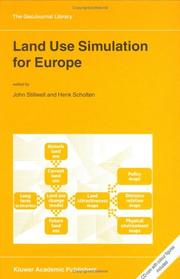
ISBN: 1402002130 9401038953 9401004668 Year: 2001 Volume: 63 Publisher: Dordrecht ; Boston : Kluwer Academic Publishers,
Abstract | Keywords | Export | Availability | Bookmark
 Loading...
Loading...Choose an application
- Reference Manager
- EndNote
- RefWorks (Direct export to RefWorks)
Land use change is driven by a variety of forces, including spatial policies formulated at supra-national, national, regional and local levels. The main focus of this book is to contextualise, explain and illustrate a new methodology for simulating land use change in different parts of Europe. It considers some of the more important causal factors and identifies state-of-the-art approaches to modelling human and environmental systems, and for evaluating and visualising altenative scenarios. The last part of the volume presents material from two case studies, one from The Netherlands and one from Portugal, of the implementation of a new simulation model called EuroScanner. Audience: This work will be of interest to researchers and practioners whose work involves geography, simulation and modelling, environmental planning, spatial decision making, the methodology of social sciences, and economics.
Geographic information systems --- Information storage and retrieval systems --- Land use --- Geografie --- Data processing. --- Remote sensing. --- Landschapskunde --- Ecologie. --- Geography. --- Economics. --- Management science. --- System theory. --- Environmental management. --- Social sciences. --- Geography, general. --- Economics, general. --- Systems Theory, Control. --- Environmental Management. --- Methodology of the Social Sciences. --- Behavioral sciences --- Human sciences --- Sciences, Social --- Social science --- Social studies --- Civilization --- Environmental stewardship --- Stewardship, Environmental --- Environmental sciences --- Management --- Systems, Theory of --- Systems science --- Science --- Quantitative business analysis --- Problem solving --- Operations research --- Statistical decision --- Economic theory --- Political economy --- Social sciences --- Economic man --- Cosmography --- Earth sciences --- World history --- Philosophy
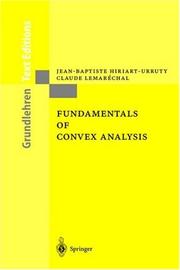
ISBN: 3540422056 3642564682 9783540422051 Year: 2001 Publisher: Berlin : Springer,
Abstract | Keywords | Export | Availability | Bookmark
 Loading...
Loading...Choose an application
- Reference Manager
- EndNote
- RefWorks (Direct export to RefWorks)
This book is an abridged version of our two-volume opus Convex Analysis and Minimization Algorithms [18], about which we have received very positive feedback from users, readers, lecturers ever since it was published - by Springer-Verlag in 1993. Its pedagogical qualities were particularly appreciated, in the combination with a rather advanced technical material. Now [18] hasa dual but clearly defined nature: - an introduction to the basic concepts in convex analysis, - a study of convex minimization problems (with an emphasis on numerical al- rithms), and insists on their mutual interpenetration. It is our feeling that the above basic introduction is much needed in the scientific community. This is the motivation for the present edition, our intention being to create a tool useful to teach convex anal ysis. We have thus extracted from [18] its "backbone" devoted to convex analysis, namely ChapsIII-VI and X. Apart from some local improvements, the present text is mostly a copy of the corresponding chapters. The main difference is that we have deleted material deemed too advanced for an introduction, or too closely attached to numerical algorithms. Further, we have included exercises, whose degree of difficulty is suggested by 0, I or 2 stars *. Finally, the index has been considerably enriched. Just as in [18], each chapter is presented as a "lesson", in the sense of our old masters, treating of a given subject in its entirety.
Convex sets. --- Convex functions --- Convex sets --- Mathematical analysis --- Computers. --- Mathematical analysis. --- Analysis (Mathematics). --- Calculus of variations. --- Operations research. --- Management science. --- System theory. --- Theory of Computation. --- Analysis. --- Calculus of Variations and Optimal Control; Optimization. --- Operations Research, Management Science. --- Systems Theory, Control. --- Systems, Theory of --- Systems science --- Science --- Quantitative business analysis --- Management --- Problem solving --- Operations research --- Statistical decision --- Operational analysis --- Operational research --- Industrial engineering --- Management science --- Research --- System theory --- Isoperimetrical problems --- Variations, Calculus of --- Maxima and minima --- 517.1 Mathematical analysis --- Automatic computers --- Automatic data processors --- Computer hardware --- Computing machines (Computers) --- Electronic brains --- Electronic calculating-machines --- Electronic computers --- Hardware, Computer --- Computer systems --- Cybernetics --- Machine theory --- Calculators --- Cyberspace --- Philosophy --- Analyse convexe --- Programmation mathematique --- Programmation convexe
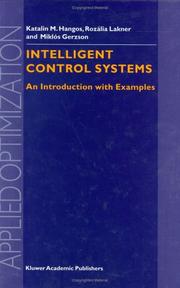
ISBN: 0306480816 1402001347 Year: 2001 Publisher: Boston, MA : Springer US,
Abstract | Keywords | Export | Availability | Bookmark
 Loading...
Loading...Choose an application
- Reference Manager
- EndNote
- RefWorks (Direct export to RefWorks)
Intelligent control is a rapidly developing, complex and challenging field with great practical importance and potential. Because of the rapidly developing and interdisciplinary nature of the subject, there are only a few edited volumes consisting of research papers on intelligent control systems but little is known and published about the fundamentals and the general know-how in designing, implementing and operating intelligent control systems. Intelligent control system emerged from artificial intelligence and computer controlled systems as an interdisciplinary field. Therefore the book summarizes the fundamentals of knowledge representation, reasoning, expert systems and real-time control systems and then discusses the design, implementation verification and operation of real-time expert systems using G2 as an example. Special tools and techniques applied in intelligent control are also described including qualitative modelling, Petri nets and fuzzy controllers. The material is illustrated with simple examples taken from the field of intelligent process control.
Computer science. --- Special purpose computers. --- Software engineering. --- Artificial intelligence. --- System theory. --- Control engineering. --- Computer Science. --- Artificial Intelligence (incl. Robotics). --- Control. --- Systems Theory, Control. --- Software Engineering/Programming and Operating Systems. --- Special Purpose and Application-Based Systems. --- Control engineering --- Control equipment --- Control theory --- Engineering instruments --- Automation --- Programmable controllers --- Systems, Theory of --- Systems science --- Science --- AI (Artificial intelligence) --- Artificial thinking --- Electronic brains --- Intellectronics --- Intelligence, Artificial --- Intelligent machines --- Machine intelligence --- Thinking, Artificial --- Bionics --- Cognitive science --- Digital computer simulation --- Electronic data processing --- Logic machines --- Machine theory --- Self-organizing systems --- Simulation methods --- Fifth generation computers --- Neural computers --- Computer software engineering --- Engineering --- Special purpose computers --- Computers --- Informatics --- Philosophy
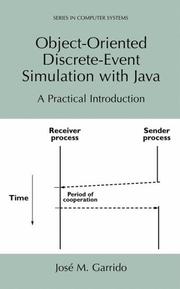
ISBN: 0306466880 1461354951 1461513197 Year: 2001 Publisher: New York, N.Y. Kluwer Academic/ Plenum Publishers
Abstract | Keywords | Export | Availability | Bookmark
 Loading...
Loading...Choose an application
- Reference Manager
- EndNote
- RefWorks (Direct export to RefWorks)
Researches and developers of simulation models state that the Java program ming language presents a unique and significant opportunity for important changes in the way we develop simulation models today. The most important characteristics of the Java language that are advantageous for simulation are its multi-threading capabilities, its facilities for executing programs across the Web, and its graphics facilities. It is feasible to develop compatible and reusable simulation components that will facilitate the construction of newer and more complex models. This is possible with Java development environments. Another important trend that begun very recently is web-based simulation, i.e., and the execution of simulation models using Internet browser software. This book introduces the application of the Java programming language in discrete-event simulation. In addition, the fundamental concepts and prac tical simulation techniques for modeling different types of systems to study their general behavior and their performance are introduced. The approaches applied are the process interaction approach to discrete-event simulation and object-oriented modeling. Java is used as the implementation language and UML as the modeling language. The first offers several advantages compared to C++, the most important being: thread handling, graphical user interfaces (QUI) and Web computing. The second language, UML (Unified Modeling Language) is the standard notation used today for modeling systems as a collection of classes, class relationships, objects, and object behavior.
Programming --- Computer programming. --- Software engineering. --- Computer simulation. --- System theory. --- Programming languages (Electronic computers). --- Mathematical models. --- Programming Techniques. --- Software Engineering. --- Simulation and Modeling. --- Systems Theory, Control. --- Programming Languages, Compilers, Interpreters. --- Mathematical Modeling and Industrial Mathematics. --- Models, Mathematical --- Simulation methods --- Computer languages --- Computer program languages --- Computer programming languages --- Machine language --- Electronic data processing --- Languages, Artificial --- Systems, Theory of --- Systems science --- Science --- Computer modeling --- Computer models --- Modeling, Computer --- Models, Computer --- Simulation, Computer --- Electromechanical analogies --- Mathematical models --- Model-integrated computing --- Computer software engineering --- Engineering --- Computers --- Electronic computer programming --- Electronic digital computers --- Programming (Electronic computers) --- Coding theory --- Philosophy
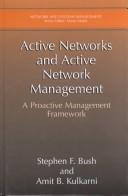
ISBN: 0306465604 9786610205561 1280205563 0306469812 Year: 2001 Publisher: New York : Kluwer Academic/Plenum,
Abstract | Keywords | Export | Availability | Bookmark
 Loading...
Loading...Choose an application
- Reference Manager
- EndNote
- RefWorks (Direct export to RefWorks)
Active networking is an exciting new paradigm in digital networking that has the potential to revolutionize the manner in which communication takes place. It is an emerging technology, one in which new ideas are constantly being formulated and new topics of research are springing up even as this book is being written. This technology is very likely to appeal to a broad spectrum of users from academia and industry. Therefore, this book was written in a way that enables all these groups to understand the impact of active networking in their sphere of interest. Information services managers, network administrators, and e-commerce developers would like to know the potential benefits of the new technology to their businesses, networks, and applications. The book introduces the basic active networking paradigm and its potential impacts on the future of information handling in general and on communications in particular. This is useful for forward-looking businesses that wish to actively participate in the development of active networks and ensure a head start in the integration of the technology in their future products, be they applications or networks. Areas in which active networking is likely to make significant impact are identified, and the reader is pointed to any related ongoing research efforts in the area. The book also provides a deeper insight into the active networking model for students and researchers, who seek challenging topics that define or extend frontiers of the technology. It describes basic components of the model, explains some of the terms used by the active networking community, and provides the reader with taxonomy of the research being conducted at the time this book was written. Current efforts are classified based on typical research areas such as mobility, security, and management. The intent is to introduce the serious reader to the background regarding some of the models adopted by the community, to outline outstanding issues concerning active networking, and to provide a snapshot of the fast-changing landscape in active networking research. Management is a very important issue in active networks because of its open nature. The latter half of the book explains the architectural concepts of a model for managing active networks and the motivation for a reference model that addresses limitations of the current network management framework by leveraging the powerful features of active networking to develop an integrated framework. It also describes a novel application enabled by active network technology called the Active Virtual Network Management Prediction (AVNMP) algorithm. AVNMP is a pro-active management system; in other words, it provides the ability to solve a potential problem before it impacts the system by modeling network devices within the network itself and running that model ahead of real time.
681.3*C23 --- 681.3*C23 Network operations: network management network monitoring public networks --- Network operations: network management network monitoring public networks --- Computer networks --- 681.3*C23 Network operations: network management; network monitoring; public networks --- Network operations: network management; network monitoring; public networks --- Management --- Management. --- Information Systems. --- Systems theory. --- Computer science. --- Computer Communication Networks. --- Computer engineering. --- Management of Computing and Information Systems. --- Systems Theory, Control. --- Processor Architectures. --- Electrical Engineering. --- System theory. --- Management information systems. --- Microprocessors. --- Computer communication systems. --- Electrical engineering. --- Electric engineering --- Engineering --- Communication systems, Computer --- Computer communication systems --- Data networks, Computer --- ECNs (Electronic communication networks) --- Electronic communication networks --- Networks, Computer --- Teleprocessing networks --- Data transmission systems --- Digital communications --- Electronic systems --- Information networks --- Telecommunication --- Cyberinfrastructure --- Electronic data processing --- Network computers --- Minicomputers --- Systems, Theory of --- Systems science --- Science --- Informatics --- Computer-based information systems --- EIS (Information systems) --- Executive information systems --- MIS (Information systems) --- Sociotechnical systems --- Information resources management --- Distributed processing --- Philosophy --- Communication systems
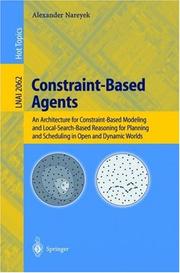
ISBN: 3540422587 3540457461 9783540422587 Year: 2001 Volume: 2062 Publisher: New York, NY ; Berlin : Springer-Verlag,
Abstract | Keywords | Export | Availability | Bookmark
 Loading...
Loading...Choose an application
- Reference Manager
- EndNote
- RefWorks (Direct export to RefWorks)
Autonomous agents have become a vibrant research and development topic in recent years attracting activity and attention from various areas. The basic agent concept incorporates proactive autonomous units with goal-directed-behaviour and communication capabilities. The book focuses on autonomous agents that can act in a goal directed manner under real time constraints and incomplete knowledge, being situated in a dynamic environment where resources may be restricted. To satisfy such complex requirements, the author improves, combines, and applies results from areas like planning, constraint programming, and local search. The formal framework developed is evaluated by application to the field of computer games, which fit the problem context very well since most of them are played in real time and provide a highly interactive environment where environmental situations are changing rapidly.
Intelligent agents (Computer software) --- Constraint programming (Computer science) --- Computer games --- Computer Science --- Engineering & Applied Sciences --- Computer games. --- Agents, Autonomous (Computer software) --- Agents, Cognitive (Computer software) --- Agents, Intelligent (Computer software) --- Assistants, Cognitive (Computer software) --- Assistants, Intelligent software --- Autonomous agents (Computer software) --- Cognitive agents (Computer software) --- Cognitive assistants (Computer software) --- IAs (Computer software) --- Intelligent agent software --- Intelligent software agents --- Intelligent software assistants --- Software agents (Computer software) --- Special agents (Computer software) --- Computer science. --- Computer communication systems. --- Computer programming. --- File organization (Computer science). --- Algorithms. --- Artificial intelligence. --- System theory. --- Computer Science. --- Artificial Intelligence (incl. Robotics). --- Systems Theory, Control. --- Programming Techniques. --- Algorithm Analysis and Problem Complexity. --- Computer Communication Networks. --- Files. --- Application software --- Electronic games --- Computer programming --- Artificial intelligence --- Computer programs --- Systems theory. --- Computer software. --- Data structures (Computer scienc. --- Artificial Intelligence. --- Data Structures and Information Theory. --- Data structures (Computer science). --- AI (Artificial intelligence) --- Artificial thinking --- Electronic brains --- Intellectronics --- Intelligence, Artificial --- Intelligent machines --- Machine intelligence --- Thinking, Artificial --- Bionics --- Cognitive science --- Digital computer simulation --- Electronic data processing --- Logic machines --- Machine theory --- Self-organizing systems --- Simulation methods --- Fifth generation computers --- Neural computers --- Communication systems, Computer --- Computer communication systems --- Data networks, Computer --- ECNs (Electronic communication networks) --- Electronic communication networks --- Networks, Computer --- Teleprocessing networks --- Data transmission systems --- Digital communications --- Electronic systems --- Information networks --- Telecommunication --- Cyberinfrastructure --- Network computers --- Information structures (Computer science) --- Structures, Data (Computer science) --- Structures, Information (Computer science) --- File organization (Computer science) --- Abstract data types (Computer science) --- Algorism --- Algebra --- Arithmetic --- Computers --- Electronic computer programming --- Electronic digital computers --- Programming (Electronic computers) --- Coding theory --- Systems, Theory of --- Systems science --- Science --- Distributed processing --- Foundations --- Programming --- Philosophy
| Listing 1 - 10 of 11 | << page >> |
Sort by
|

 Search
Search Feedback
Feedback About
About Help
Help News
News